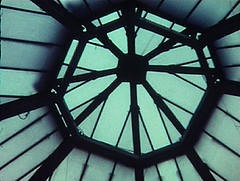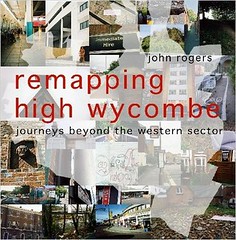Reframing Maidstone - a kino derive
It's an event where archive film clips of the town are transfered to people's mobile phones, they then hunt down the locations of the clips using clues we give them, shoot their own response to the footage and the location, then bring their own clips back the installation at Maidstone Town Hall where they are loaded onto a video map displayed on large plasma screens.
We did it last Saturday and it worked really well, and it will run again tomorrow. If you'd like to participate but can't make it along you can send us a clip of whereever you are and we'll send you a clip of Maidstone in return. (email: reframingmaidstone@googlemail.com)
I've written an outline of the idea of the Kino Derive:
Self-authorship of the landscape: from the Phantom Ride to the Mobile Phone
"The modern avenue served as laboratory for the flâneur, while the contemporary street finds the neo- flâneur manipulating the mediating filters of technology in pursuit of new connections to the landscape." Glenn Bach. Atlas Peripatetic (MFA Project Report).
<1> Film-maker Patrick Keiller has identified that a common feature of the early city films of late 19th and early 20th Century was that they tended to be "one to three minutes long, and consisted of one or very few unedited takes". This format is again becoming popular with the using of online video-sharing, self-broadcasting websites such as YouTube and Google Video. The development of portable devices such as mobile phones presents new opportunities for topographical film-makers as short clips can be shot on the move and sent directly from the location to a website, or another device, where they can be simultaneously viewed and commented upon.
<2> This also has implications for the time-space compression (David Harvey) as people can broadcast to a potentially large audience images of the landscape as they pass through it in real-time and experience moving image bulletins from the past in-situ. Like the early city films these clips or bulletins will necessarily be short and unedited.
<3> Our visions of the landscape can now be filtered through a digital interface. Collectively these visions form a snapshot of the townscape and the personal topographies of the auteurs. The exchange that takes place on a kino dérive between author and instigator/ provocateur transforms the personal into the shared experience of space and place, spanning past and present.
A video map is created, logging the journeys undertaken. This then enables us to explore the changes and tensions, highlight historic symmetries and developments.
<4> By viewing archive film images in situ what historical tensions emerge? When standing in Fremlin Walk looking at Sonny Hanson’s film showing Fremlins Brewery in 1938 it’s difficult not to become aware of the economic and cultural transformation that has occurred as we have moved from distinctive local industries to a homogenised shopping mall culture.
<5> Can this simple act of authoring our own representation of our environment somehow give us a link to collective sense of place beyond that defined by urban planning, the privatisation of public space and received notions of localness and belonging? Somehow enable access to what Nick Papadimitriou calls a kind of "regional memory" locked in the landscape. A route to a sense and spirit of place which is inclusive.
<6> With the traditional psychogeographical dérive or drift we seek to strip the city or town bare, to reveal its secrets, its mechanisms and motors. The motivations for engaging in such an activity vary as much as the outcomes. For the Situationists it was a reconnaisance mission for the revolution of everyday life that they sought to bring about. The fact that they moved on from drinking absinthe in Montmatre to being at the heart of the revolt of May ’68 that brought the French government to the brink of collapse suggests some use came from these "journeys outside the timetable."
<7> With a kino dérive we don’t anticipate a revolution in the traditional sense to occur, although it would be nice. It is an experiencing of place through a simultaneous active engagement with moving image and the landscape.
Labels: derive



